A letter of recommendation for coworker example is a document that talks about the coworker’s skills, achievements, and good qualities. It is usually written by someone who has worked closely with a coworker, like a manager or another colleague.
Purpose and Importance
The purpose of this letter is to help your coworker when they apply for a new job or a promotion. It is important because it gives the employer a better idea of who your coworker is and what they can do. This letter can help your coworker stand out and show that they are a great candidate for the position.
Key Components of a Letter of Recommendation
Introduction
How to Start the Letter
To start a letter of recommendation, begin with a warm greeting. Use phrases like “Dear [Recipient’s Name],” or “To whom it may concern,”. Then, introduce yourself and explain how you know the coworker. Mention how long you have worked together.
Body
Detailed Achievements and Skills
In the body of the letter, talk about your coworker’s achievements and skills. Give specific examples of their work performance. Mention any projects they excelled in and how well they work with the team. Describe their unique strengths and why they are a valuable team member.
Conclusion
How to Close the Letter
End the letter by summarizing why you recommend your coworker. Express confidence in their abilities and say that you believe they will do well in the new job or role. Use a closing phrase like “Sincerely,” followed by your name and position.
Tone and Style
Appropriate Tone
When writing a letter of recommendation for a coworker, it is important to use a tone that is both friendly and professional. The tone should show that you respect and support your coworker. It should also show that you are confident in their abilities. Avoid using casual language or slang. Instead, use words that sound respectful and positive.
Professional Language
Using professional language means writing in a clear and formal way. Avoid using too many big words or complicated sentences. Keep your writing simple and easy to understand. Here are some tips for using professional language:
- Be Positive: Use positive words to describe your coworker. Instead of saying “They are okay at their job,” say “They are excellent at their job.”
- Be Specific: Give specific examples of what your coworker has done well. Instead of saying “They are good at projects,” say “They led the project on time and with great success.”
- Be Honest: Only write what you know to be true about your coworker. Do not exaggerate or make things up.
- Be Clear: Make sure your sentences are clear and easy to read. Avoid using too many long sentences. Break up your ideas into smaller parts.
- Be Respectful: Always write in a way that shows respect for your coworker. Use polite words and phrases.
Using the right tone and language will make your letter of recommendation strong and effective. It will show that you truly believe in your coworker’s abilities and that you are serious about recommending them.
Here is an example of using the right tone and professional language:
Example:
“I am delighted to recommend Jane for the position of Project Manager. Jane has shown excellent skills in managing projects and leading our team. She always meets deadlines and provides high-quality work. Her positive attitude and strong work ethic make her a valuable team member. I am confident that Jane will excel in her new role and be a great asset to your company.”
In this example, the tone is positive and professional. The language is clear and easy to understand. The sentences are short and to the point. This makes the recommendation strong and convincing.
Length and Structure
Ideal Length
It should be one to two pages long. This length is just right to give enough detail without being too long. It should be long enough to cover all the important points but short enough to keep the reader’s interest.
Format and Structure
A letter of recommendation should have a clear format and structure. Here is a simple way to organize it:
- Introduction: Start by saying who you are and how you know the coworker. Mention how long you have worked together.
- Body: In this part, write about the coworker’s skills and achievements. Give specific examples of their work performance and how they work with the team.
- Conclusion: End by summarizing why you recommend your coworker. Express confidence in their abilities.
Here is an example of a well-structured letter:
Contoh Gambar
Examples of Achievements and Skills to Mention
Include specific examples of your coworker’s work performance and their ability to collaborate with the team. For example, “Jane consistently met her project deadlines and contributed innovative ideas.”
Sample Openings
- Formal Opening: “I am pleased to recommend [Coworker’s Name] for [Position].”
- Friendly Opening: “It is my pleasure to write this letter for my colleague, [Coworker’s Name].”
Sample Closings
- Strong Closing: “I am confident that [Coworker’s Name] will be a valuable asset to your team.”
- Neutral Closing: “I believe [Coworker’s Name] would excel in this position.”
Work Performance
When writing about your coworker’s work performance, give specific examples of what they have done well. This makes your letter more convincing. Here are some examples:
- Meeting Deadlines: “Jane always meets her deadlines. For example, she completed the annual report two weeks early.”
- Quality of Work: “John’s work is always of high quality. He double-checks everything to make sure it is correct.”
Team Collaboration
Teamwork is very important in many jobs. Mention how well your coworker works with others. Here are some examples:
- Helping Others: “Sarah is always willing to help her teammates. She often stays late to help others finish their tasks.”
- Positive Attitude: “Michael has a positive attitude that boosts team morale. His colleagues enjoy working with him.”
Examples:
- Work Performance:
- “Jane led the team in completing the new software development project. She made sure everything was done on time and within budget.”
- “John improved our filing system, making it faster and easier to find documents. This saved us a lot of time.”
- Team Collaboration:
- “Sarah helped new team members get up to speed quickly. She always shares her knowledge and supports others.”
- “Michael’s positive attitude makes him a great team member. He encourages everyone and helps keep the team motivated.”
Using these examples in your letter will show that your coworker is not only good at their job but also great at working with others. This makes your recommendation stronger and more effective.
Letter of Recommendation for Coworker Example
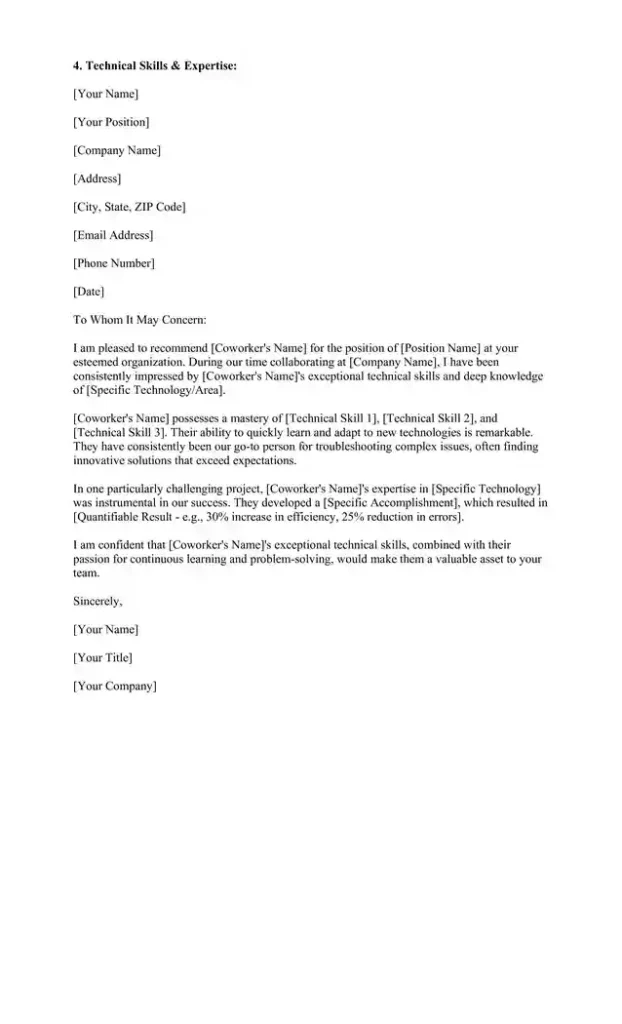
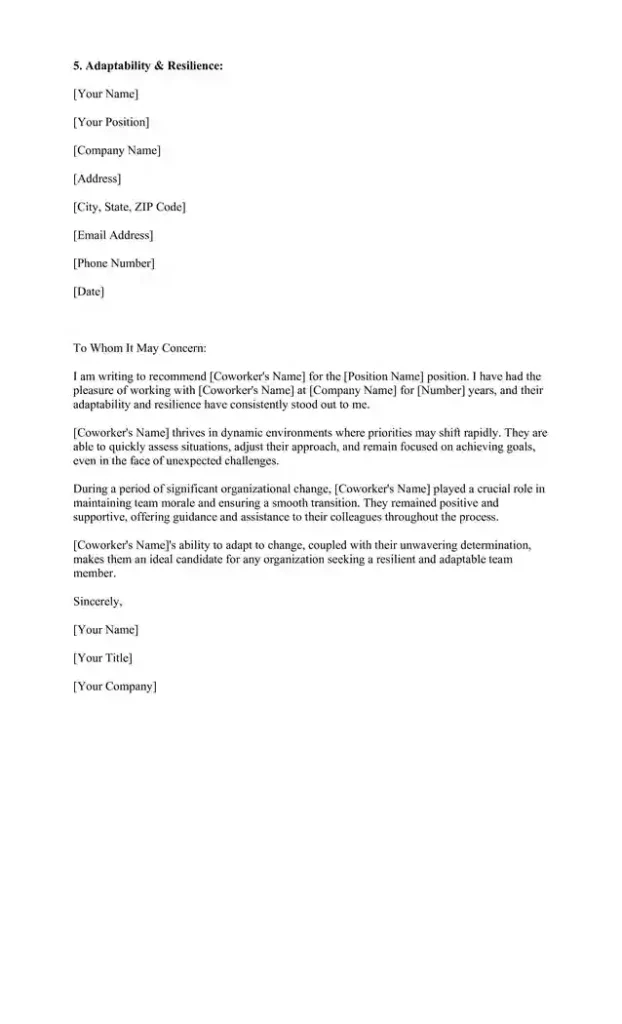
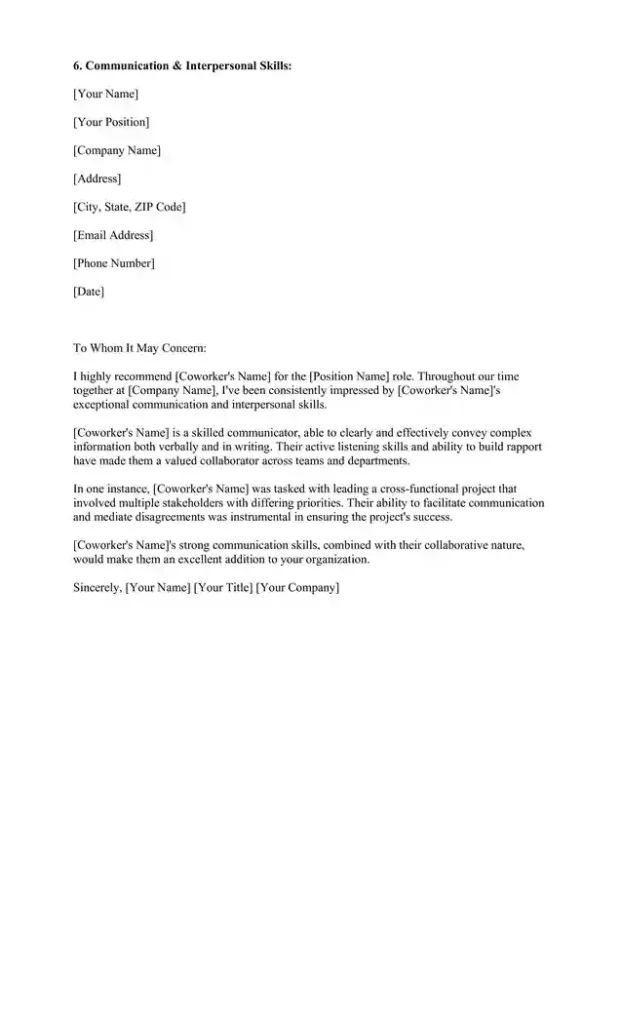
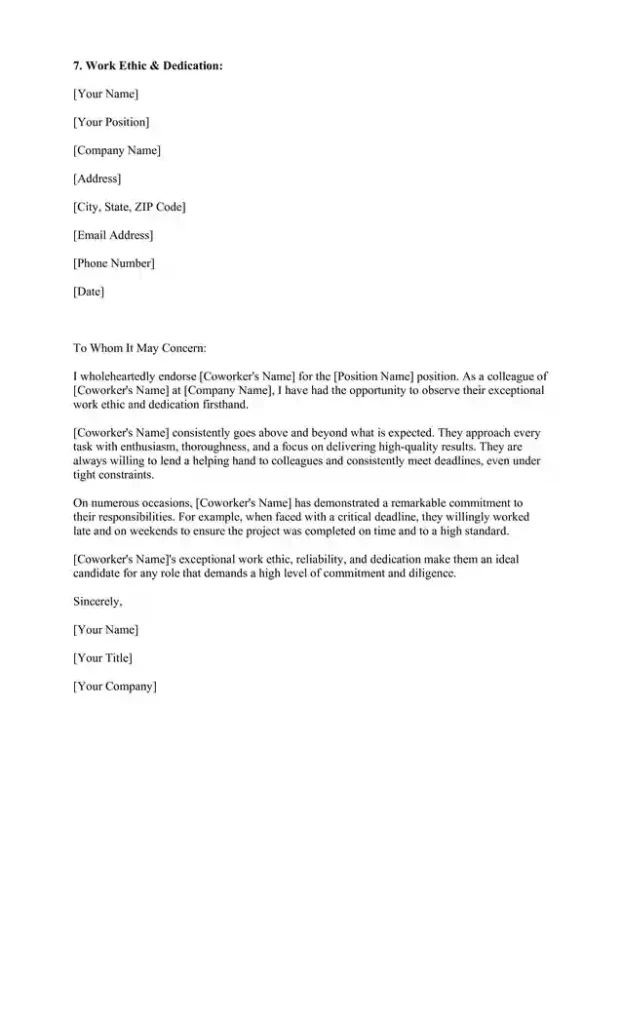
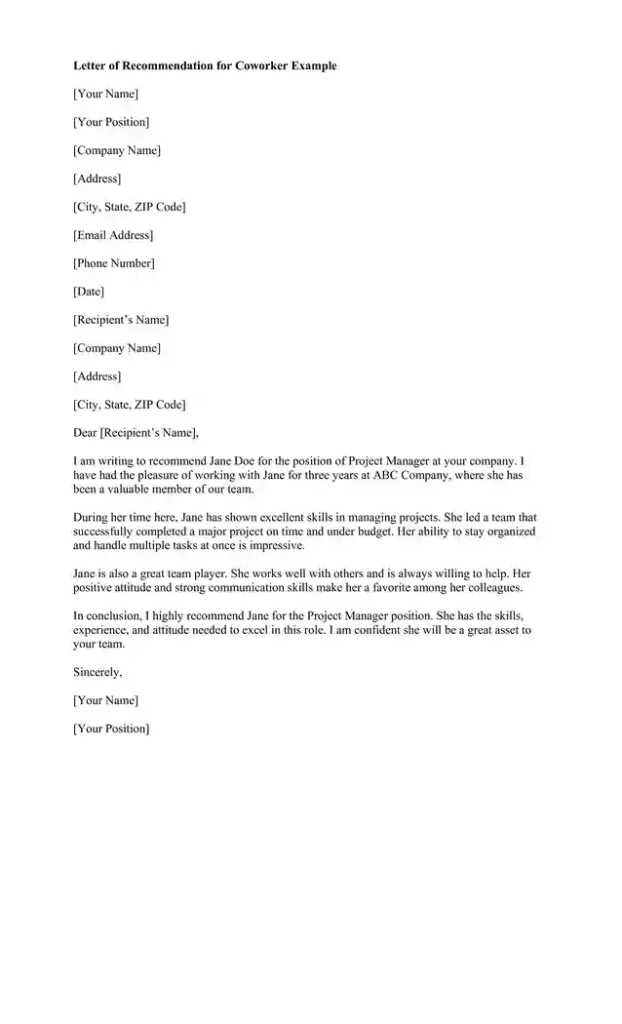
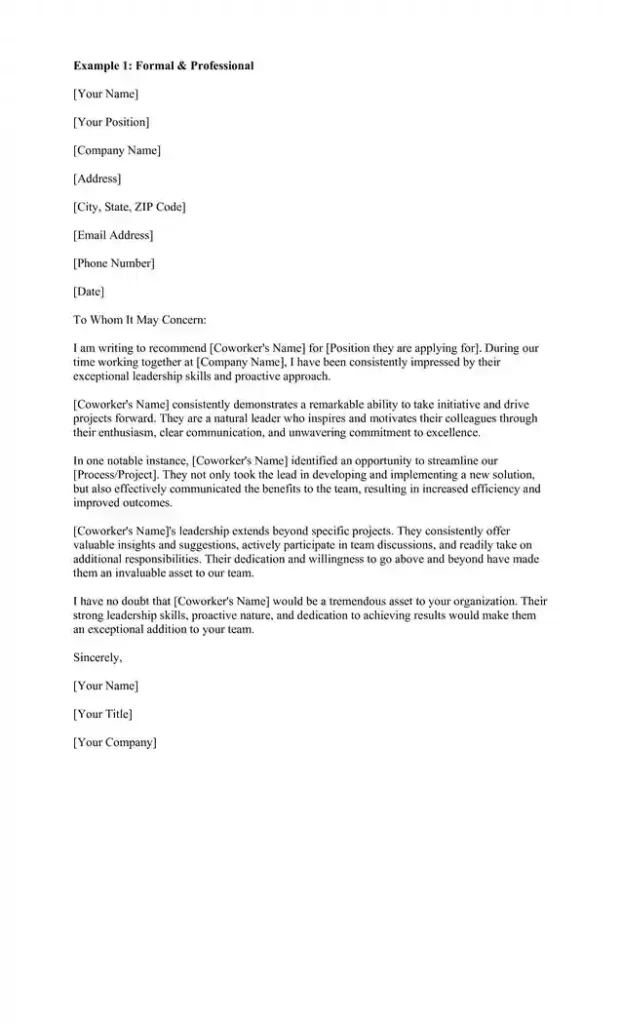
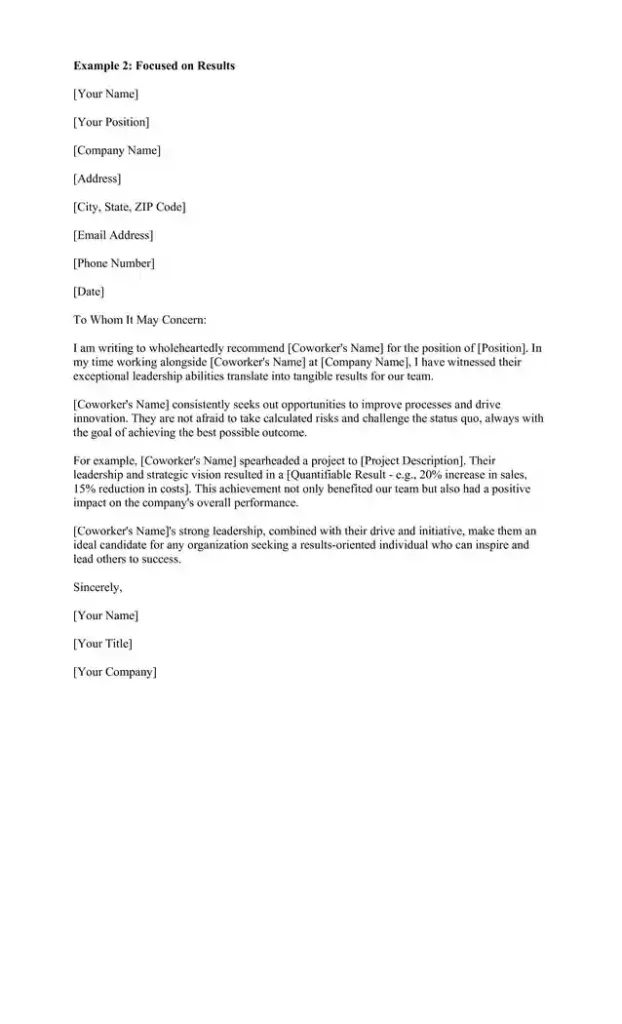
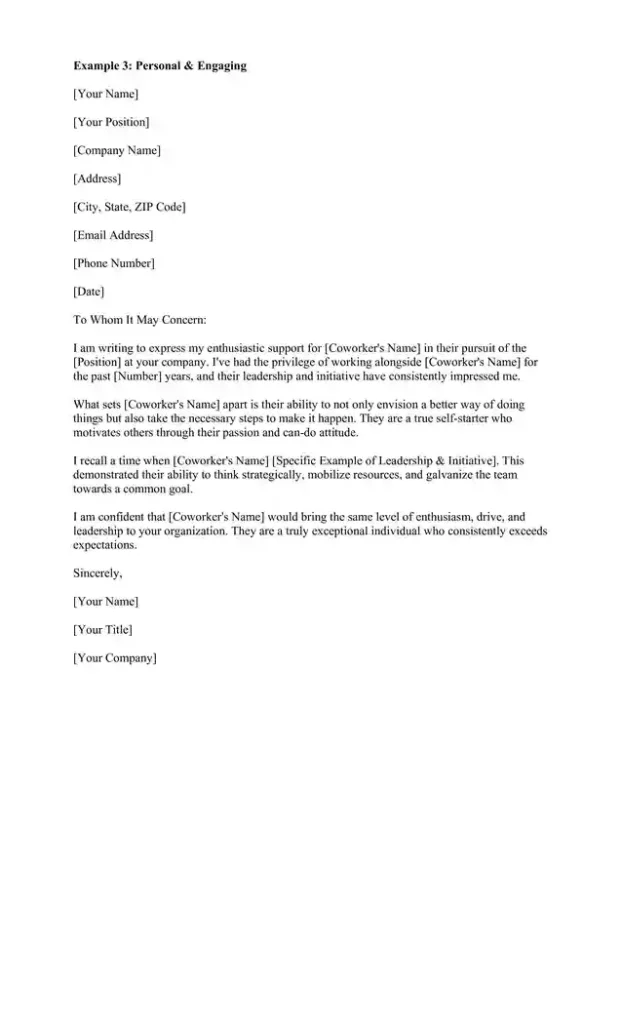
Common Mistakes to Avoid
It is important to avoid certain mistakes. These mistakes can make your letter less effective or even harm your coworker’s chances of getting the job. Here are some common mistakes to watch out for:
Being Too Vague
- Mistake: Writing general statements like “They are a good worker.”
- Fix: Be specific. Mention exact projects, skills, and achievements. For example, “Jane led the team to complete the project two weeks early.”
Using Casual Language
- Mistake: Using slang or informal language like “They’re awesome!”
- Fix: Use professional and polite language. Say, “They are highly skilled and professional.”
Making It Too Long
- Mistake: Writing a letter that is too long and detailed.
- Fix: Keep the letter to one or two pages. Focus on the most important points.
Not Proofreading
- Mistake: Sending the letter with spelling or grammar mistakes.
- Fix: Always proofread your letter. Check for errors and ask someone else to review it.
Exaggerating or Lying
- Mistake: Overstating your coworker’s abilities or making things up.
- Fix: Be honest. Only write about what you know is true. For example, if they were part of a project team, don’t say they led it unless they really did.
Being Too Brief
- Mistake: Writing only a few sentences.
- Fix: Give enough detail to make a strong recommendation. Include specific examples of their skills and achievements.
Ignoring the Job Description
- Mistake: Not mentioning skills relevant to the job they are applying for.
- Fix: Tailor the letter to the job description. Highlight the skills that match what the employer is looking for.
Not Including Your Contact Information
- Mistake: Forgetting to add your contact details.
- Fix: Always include your name, position, company, email, and phone number. This makes it easy for the employer to contact you if they have questions.
Writing in a Hurry
- Mistake: Rushing to write the letter without putting in much thought.
- Fix: Take your time. Think about what makes your coworker special and write a thoughtful letter.
Using a Generic Template
- Mistake: Using a one-size-fits-all template without personalizing it.
- Fix: Personalize the letter. Mention specific details about your coworker that show you know them well.
By avoiding these common mistakes, you can write a strong and effective letter of recommendation. This will help your coworker stand out and increase their chances of success.
Final Tips
Proofread your letter to avoid any mistakes. Add personal touches to make the letter more heartfelt. Mention how long you have known the coworker and in what capacity.



